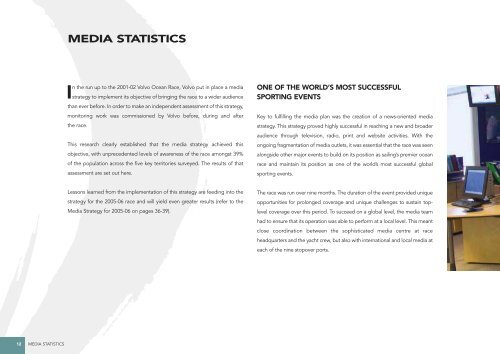Volvo Ocean Race: Overview, Marketing, History
Volvo Ocean Race: Overview, Marketing, History
Volvo Ocean Race: Overview, Marketing, History
You also want an ePaper? Increase the reach of your titles
YUMPU automatically turns print PDFs into web optimized ePapers that Google loves.
12 MEDIA STATISTICS<br />
MEDIA STATISTICS<br />
In the run up to the 2001-02 <strong>Volvo</strong> <strong>Ocean</strong> <strong>Race</strong>, <strong>Volvo</strong> put in place a media<br />
strategy to implement its objective of bringing the race to a wider audience<br />
than ever before. In order to make an independent assessment of this strategy,<br />
monitoring work was commissioned by <strong>Volvo</strong> before, during and after<br />
the race.<br />
This research clearly established that the media strategy achieved this<br />
objective, with unprecedented levels of awareness of the race amongst 39%<br />
of the population across the five key territories surveyed. The results of that<br />
assessment are set out here.<br />
Lessons learned from the implementation of this strategy are feeding into the<br />
strategy for the 2005-06 race and will yield even greater results (refer to the<br />
Media Strategy for 2005-06 on pages 36-39).<br />
ONE OF THE WORLD’S MOST SUCCESSFUL<br />
SPORTING EVENTS<br />
Key to fulfilling the media plan was the creation of a news-oriented media<br />
strategy. This strategy proved highly successful in reaching a new and broader<br />
audience through television, radio, print and website activities. With the<br />
ongoing fragmentation of media outlets, it was essential that the race was seen<br />
alongside other major events to build on its position as sailing’s premier ocean<br />
race and maintain its position as one of the world’s most successful global<br />
sporting events.<br />
The race was run over nine months. The duration of the event provided unique<br />
opportunities for prolonged coverage and unique challenges to sustain toplevel<br />
coverage over this period. To succeed on a global level, the media team<br />
had to ensure that its operation was able to perform at a local level. This meant<br />
close coordination between the sophisticated media centre at race<br />
headquarters and the yacht crew, but also with international and local media at<br />
each of the nine stopover ports.




